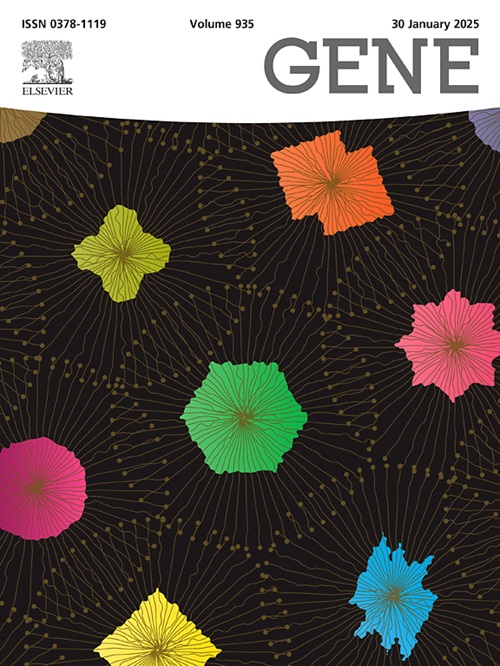Analysis of rosmarinic acid synthase (RAS) gene family and functional study of SmRAS1/2/4 in Salvia miltiorrhiza
IF 2.4
3区 生物学
Q2 GENETICS & HEREDITY
引用次数: 0
Abstract
Rosmarinic acid synthase is an essential enzyme involved in the biosynthesis of rosmarinic acid (RA), which facilitates the coupling of phenylpropanoid and tyrosine-derived pathway products. Our study identified six SmRAS genes in Salvia miltiorrhiza, with SmRAS1 being the only one functionally characterized to date. Real-time quantitative PCR was employed to analyze the expression profiles of the SmRAS gene family, revealing that SmRAS1/2/4 are predominantly expressed in the roots, which are the medicinal components of S. miltiorrhiza. SmRAS2 and SmRAS4 exhibited significant responses to abscisic acid (ABA), gibberellin (GA3), and methyl jasmonate (MeJA) stimuli, while SmRAS1 had notable responses to GA3 and MeJA. β-glucuronidase (GUS) staining in transgenic Arabidopsis thaliana confirmed a spatiotemporal expression pattern of SmRAS1/2/4 that was consistent with the qRT-PCR results. SmRAS1/2/4 are primarily localized to the cytoplasm and plasma membrane. Our findings suggested that the overexpressions of SmRAS1 or SmRAS4 led to increased levels of salvianolic acid B (SalB) and RA, with a concomitant decrease in the Danshensu (DSS) content, which served as a substrate. In contrast, RNA interference lines exhibited a downward trend in the content of these substances. Interestingly, no significant changes were detected in the SalB, RA, or DSS contents due to the overexpression of SmRAS2 or RNA interference lines. Collectively, our study demonstrated that SmRAS1 and SmRAS4 are key regulators of RA and SalB biosynthesis in S. miltiorrhiza, while SmRAS2's role appears less impactful, suggesting a complex regulatory network that influences the medicinal properties of this plant.
丹参中的迷迭香酸合成酶(RAS)基因家族分析和 SmRAS1/2/4 的功能研究
迷迭香酸合成酶是参与迷迭香酸(RA)生物合成的一种重要酶,它促进了苯丙氨酸和酪氨酸衍生途径产物的耦合。我们的研究在丹参中发现了六个 SmRAS 基因,其中 SmRAS1 是迄今为止唯一一个具有功能特征的基因。我们采用实时定量 PCR 分析了 SmRAS 基因家族的表达谱,发现 SmRAS1/2/4 主要在根部表达,而根部是丹参的药用成分。SmRAS2 和 SmRAS4 对脱落酸(ABA)、赤霉素(GA3)和茉莉酸甲酯(MeJA)的刺激有明显的反应,而 SmRAS1 对 GA3 和 MeJA 有显著的反应。转基因拟南芥中的β-葡糖醛酸酶(GUS)染色证实了SmRAS1/2/4的时空表达模式与qRT-PCR结果一致。SmRAS1/2/4主要定位于细胞质和质膜。我们的研究结果表明,SmRAS1或SmRAS4的过表达会导致丹参酚酸B(SalB)和RA含量的增加,同时作为底物的丹参素(DSS)含量也会降低。与此相反,RNA 干扰品系中这些物质的含量呈下降趋势。有趣的是,过表达SmRAS2或RNA干扰品系导致的SalB、RA或DSS含量均未发现明显变化。总之,我们的研究表明,SmRAS1 和 SmRAS4 是 S. miltiorrhiza 中 RA 和 SalB 生物合成的关键调控因子,而 SmRAS2 的作用似乎影响较小,这表明有一个复杂的调控网络影响着这种植物的药用特性。
本文章由计算机程序翻译,如有差异,请以英文原文为准。
求助全文
约1分钟内获得全文
求助全文
来源期刊

Gene
生物-遗传学
CiteScore
6.10
自引率
2.90%
发文量
718
审稿时长
42 days
期刊介绍:
Gene publishes papers that focus on the regulation, expression, function and evolution of genes in all biological contexts, including all prokaryotic and eukaryotic organisms, as well as viruses.
 求助内容:
求助内容: 应助结果提醒方式:
应助结果提醒方式:


